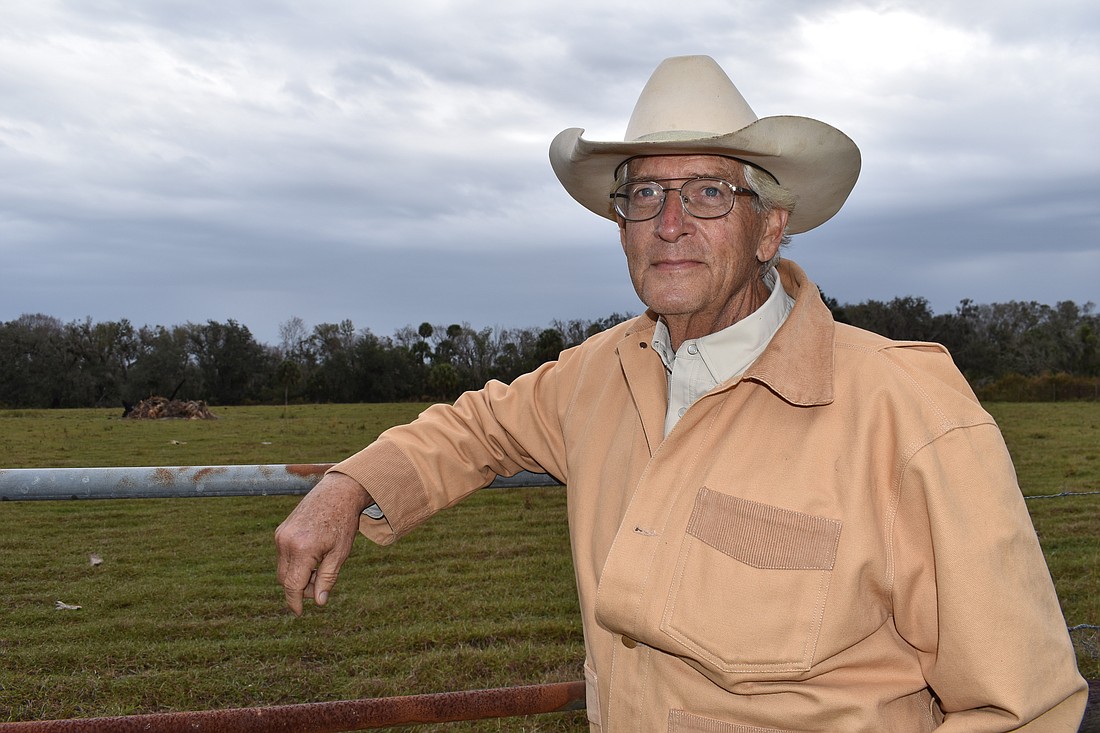Rancher says Manatee County faces key conservation decisions
Myakka’s Jim Strickland says Florida is headed toward ecological disaster if the public doesn’t deal with important issues now.
- By Jay Heater
- | 5:00 a.m. January 17, 2024

Late in Jim Strickland’s Myakka ranching career, it must feel like he has a different job. Strickland’s role as a rancher and conservationist has led him into the role of teacher, and that’s OK with him. Asked if he would consent to an interview to preview his upcoming webinar, the 68-year-old Strickland paused, and asked, “Which one?”
Strickland’s position as vice chair of the Florida Conservation Group, and being past president of the Florida Cattleman’s Association, has made him an active speaker on disappearing ranch lands and farmlands and what that impact will be. He said education of the general public is the key to stopping what could be an impending ecological disaster. The webinar in question is the Florida Agriculture 2040/2070 webinar, presented by 1000 Friends of Florida. It will begin at noon Jan. 24 and also features Tom Hoctor and Michael Volk of the University of Florida Center for Landscape Conservation.
The speakers will talk about Florida’s projected future in terms of land use, and what effect that will have on the environment.”We will talk about impact of population growth, related development and sea level rise on Florida’s agricultural lands and their conversation values,” Strickland said. “It will look at ambient light, sea rise, and future construction of highways, among other topics. “What you will hear will make you want to conserve land,” Strickland said. “We have been looking five years down the road, and we should be looking 50 years down the road. We should be looking 500 years down the road. The water is what brought a lot of people here. But nutrients from all these homes are worse than nutrients that come from the farms.”
Not anti-development
Strickland stressed that he is not anti-development, but he said it has to be done without disregard for what green space means to society. He said some developers are making modifications to their developments with an eye toward conservation, but others, not so much.
“Every development (in Manatee County) used to be a cattle ranch,” he said. “But there is a reason people sell out. If we were making tremendous money selling cows, there would be more ranches. And think about someone who has a 10,000-acre ranch who has 10-to-12 heirs. They all can’t make a living on that ranch. It also is hard work, and (the heirs) might have different passions.”
In 1973 at the age of 17, Strickland had to take over cattle operations on his family’s Strickland Ranch after the death of his father, Hiram Strickland. As development spread through the western parts of the county, Strickland took his ranching operations farther east in the county.
Conservation easements needed
Strickland, in his Florida Conservation Group role, advocates and lobbies for funding that supports programs that produce conservation easements. The Florida Conservation Group bills itself as a science-based organization for the protection of Florida’s ranch lands.
Progress is being made. On Jan. 11, the USDA Natural Resources Conservation Service’s Florida office released its annual report, stating that it completed restoration, repair and stewardship of 28,899 acres of easements in the state in the past fiscal year. Currently, NRCS conservation easements protect 288,131 acres in Florida. Strickland said that currently, ranchers in Florida have applications pending approval to receive conservation easements for more than 300,000 acres. Those acres undergo a ranking procedure to get in line for funds. However, even if funding could be found for all that acreage, he said it would not be enough. He said it is a “triage” situation where it is the best answer for the time being.
So he wears his teacher’s cowboy hat as often as possible. “I just gave Manatee County a presentation on conservation easement,” he said. “I talk about how green space benefits greater society. What is it worth to preserve the habitat of the Florida Panther? What are our wetlands worth?”
While his family ranching history in Florida dates back to 1845, not all ranchers have the same priorities when it comes preserving land. However, he said many do have a conservation mindset, but they need to see the “financial benefit” of selling their property rights for a conservation easement. He said that is rightfully so. “Ranchers are being paid $3,500 to $4,000 an acre for development rights,” he said. “The marketplace drives the boat, and if developers are willing to pay $100,000 an acre, that will be tough.”
He said that is why it is so important to push for “repetitive funding,” where conservation easement funds are made available on an annual basis. That would mean convincing a lot of people who aren’t ranchers or farmers about the importance of providing those funds. “Agriculture is less than 2% of our population,” he said. “I don’t have enough votes out there to make anyone think twice. But at some point, you have to think how much is the last species of a bird worth? We need to go down those roads now. Knowing what Florida will look like in the future will help us make decisions today.”
